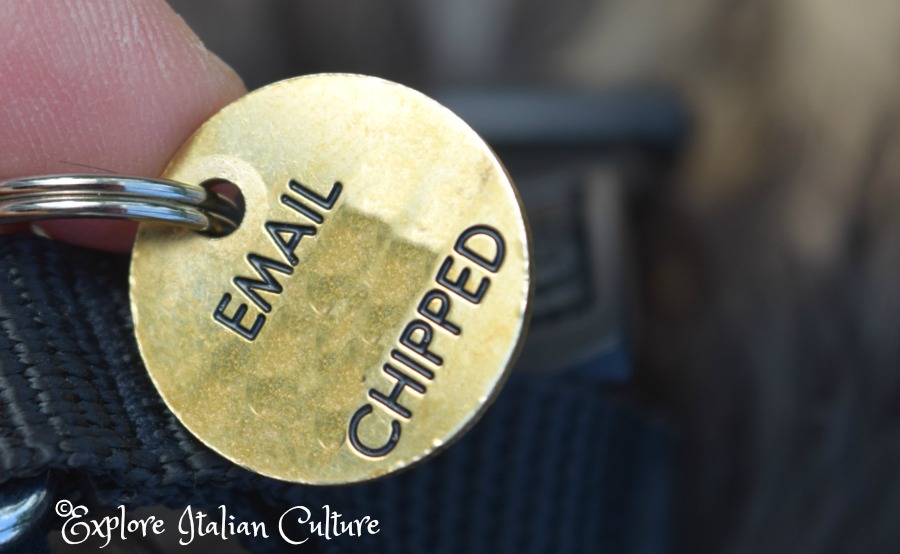The pet microchip: is it really necessary for animals in Italy?
Whether you're travelling to Italy with your pet, or living here, a microchip is an essential part of making sure your furry friend is both legal, and safe.
Here's why, and what you need to do.
Travelling to Italy: basic facts about your pet's microchip.
- It's compulsory for all animals travelling to Italy to be microchipped - including service animals. It doesn't apply to rodents and birds.
- If your pet is travelling to Italy (or anywhere in Europe), the microchip must be in place before s/he has the compulsory rabies inoculation.
- The chip must be compliant with ISO-11784 - your veterinarian will make sure of this.
- An ear tattoo is accepted as an identifying marker only if it was applied before 3 July, 2011. However, it's much better to be safe and have a microchip to avoid any confusion.
- If there's no microchip (or tattoo in the circumstances outlined above), the animal will either be sent back to wherever it came from, or put into quarantine at the owner's expense.
Living in Italy: basic facts about your pet's microchip.
- It has been a legal requirement in Italy since early 2017 that all adult cats and dogs must be microchipped.
- Even if it weren't illegal, it's good practice to have your pets microchipped. There's evidence that 90% of non-chipped animals who get lost are never returned to their owners.
- It's helpful to have a statement on your dog's tag to say he or she is chipped. That way, s/he can be easily and quickly identified, if s/he does get lost.
 Our Yorkie, Effie's identity medal gives our telephone number on one side, and email with the single word "Chipped" on the other.
Our Yorkie, Effie's identity medal gives our telephone number on one side, and email with the single word "Chipped" on the other.The microchip: what is it - and does it hurt to put one in?
- The microchip is exactly what the name implies: a tiny chip which is injected just below the skin. If your dog or cat has very thin skin, you may even be able to feel it.
- It contains an unique 15 digit number which can be read by a hand-held scanner. The chip number is registered to the owner and is then signed off by the vet on all your pet's documents - vaccination certificates, pet passport and, importantly, the rabies vaccine certificate.
- It's not much bigger than a grain of rice. The needle used to inject it is slightly bigger than the needle used to give your pet its normal annual booster.
- It takes just seconds to implant it - about the same time as any injection.
- Animals don't need an anaesthetic to have it done. Does it hurt? Probably about as much as taking blood hurts, because the needle is just a little thicker than an injection needle.
- Pets can be microchipped when they're still very young. The Kennel Club recommends that puppies should not be chipped before they're 6 weeks old.
- To be compliant with regulations, though, it should be done before the animal is 8 weeks old. So the optimum time is between 6 and 8 weeks of age.
Important information.
Different countries place the microchip in different positions. In the UK, for example, it's always between the shoulder blades. In Italy, on the other hand, the law states that the chip must be placed behind the left ear.
Not knowing where it is can cause problems at scanning points. On one occasion, before we realised this, we weren't able to find our Maremma's chip. That could have led to her needing to be quarantined.
Make sure you check with your vet before you travel, so you know exactly where your dog's microchip is.
The scanner.
- The microchip needs to be read by a hand-held scanner which electronically notes the unique number identifying the pet.
- Sometimes, non-European chips can't be read by European scanners. If you're travelling to Italy and you're in any doubt, buy a scanner which is able to read your dog's chip before you travel.
This simple scanner for 15 digit US chips is available from Amazon.com - click on this link or on the pic to buy.

- The scanner is simply swept over the pet's coat in the place where the chip was inserted and beeps when it finds it. The scan usually takes just a few seconds.
- The scanner is used whenever the pet needs to be identified: at the point of giving the rabies vaccine; at the point of entry into any European country; by the police or shelters should the animal get lost.
How do we know all this?
- All our dogs have had pet passports, so all have had to be microchipped. None of them batted an eyelid when it was done, and it has never caused any of them any problems.
- We can feel Effie's because Yorkshire Terriers have notoriously thin skin. We used to have a greyhound - Nero - and we could also feel his.
- It's easy to mistake the chip for a tiny, rice-grain-sized, lump.
Can anything go wrong?
- Very occasionally, the chip can move position. It can be very disconcerting when waiting at a border to be told you can't enter unless the chip can be found so please, always check the position before you travel.
Our Top Tips.

- It's wise to double check the number written in your pet's passport to make sure it's the same one on the documentation that comes with the microchip. It's easy in a busy vet's surgery for mistakes to be made, and the last thing you want is to be stranded at an airport because the numbers don't tally.
- It's possible to buy a pet microchip on the internet. Be careful of this. For your pet's safety it should always be bought from and applied by a registered veterinarian.
- If your dog has a tattoo, don't rely on it, particularly if you're travelling into the UK. It won't be accepted. You need to make sure your dog has been microchipped.
- We've found that at borders we are usually given the scanner, asked to scan the dog ourselves and then hand the scanner back to border control. So before you travel, make sure you know how to use one, and make sure your dog isn't frightened by it. Ask your vet if you can practice with theirs.
- Once again, a warning: different countries place the chip in different positions. Make sure you know where your dog's is.
More information about travelling with dogs.
Sources and further information.
The European directive about the pet passport scheme, including information about the requirement to microchip (at Article 4), can be found at this link. Be aware though - it's written in "legaleze", so doesn't make for easy reading!
This is the Italian Ministry of Health's English site, outlining in detail all requirements for animals entering Italy.
Want to know more about microchips generally, or specifically about compatibility between the US and the European Union? This Wiki page is full of good information (opens in a new window).
Some links on this page are affiliate links, which means that if you purchase a product through them, we receive a small commission. There is no extra cost to you. To learn more please see our affiliates disclosure document.
Disclaimer.
Regulations regarding taking pets from one country to another can sometimes change without notice. For this reason, my article should be regarded as general advice only. Always check the information on your own country's website, and discuss what's needed with your veterinarian as soon as you decide to take your pet out of the country.
Disclaimer.
I make every effort to provide readers of my site with information which has been confirmed by scientific, peer-reviewed research, particularly where health issues are concerned. However, I am not a trained medical practitioner and I give this information as general advice only. If you have any concerns about your pet, you should see your own veterinary surgeon immediately.









